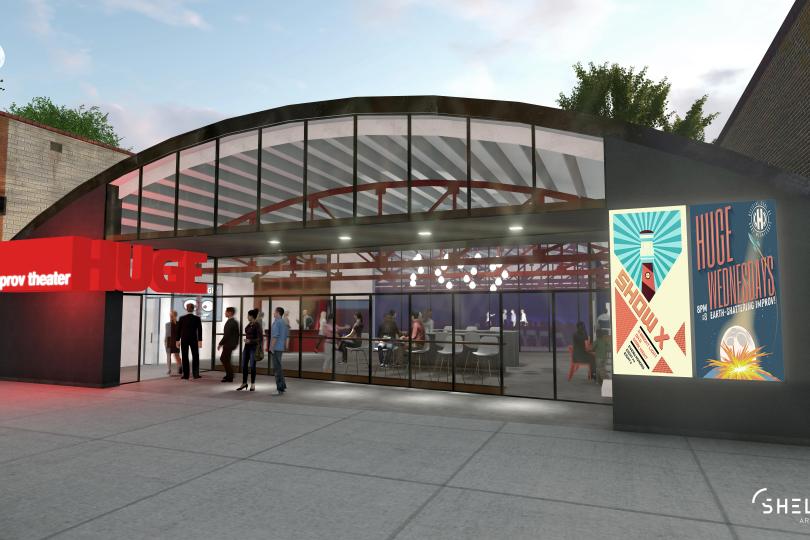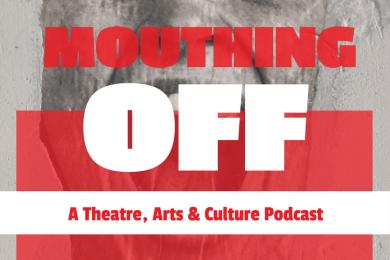HUGE Improv Theater's Capital Campaign

Jill Bernard, Rita Boersma, Sean Dillon, and Butch Roy of HUGE Improv Theater kindly shared their insights about their capital campaign with Minnesota Playlist's Damon Runnals.
DR: Your announcement to buy a building came with an immediate deadline to raise $640,000, yet you had been looking for a building for a while. Was the plan always to run a capital campaign once a potential purchase was identified? Talk to me about how this particular building altered (or didn’t) your purchase plans.
SD: Our experience has been, it is tough to get traction on capital fundraising if you can’t get specific about what it is funding… what, and where, and how much. So we were always aware that the campaign would have to follow finding a potential building. This particular opportunity was too good to pass up, but it did come with a shorter runway than we might have chosen for ourselves.
BR: Not only was the building way too good to pass up (being in our neighborhood, right size and more) but the owners’ interest in having time to find a new space and move fit our fundraising needs - the immediate goal is just to close the sale but in a lot of ways represents just how much the commercial real estate market doesn’t really fit with the arts capital fundraising model, properties that are a great solution for an arts organization don’t stay while you raise funds at the normal pace, we had to take a shot raising funds at the pace the market moves instead.
DR: How does this fundraising level compare with what you’ve raised annually in the past?
SD: Well, in 2018, we saw about $100,000 in individual donations, and $100,000 in grant funding. So this is definitely more ambitious, but not insurmountably so.
JB: Wow, Sean, what a calm answer! I think the really tricky part is that we are still running a theater that needs funding while we are trying to fund a new theater. That makes it complicated. It won’t help if people who would normally donate towards our daily operating expenses who are shifting that money to the capital campaign, we will have to find new funding and new donors.
BR: It’s not just a bigger number, it’s a whole different kind of scale - instead of a vague goal of “help us continue being” you have the immediate impact of THE BUILDING but it’s also different in terms of how far donations go - this isn’t just operating costs and we’ll be back next year to ask for more, this is a permanent change to the operations and organization and programs...hopefully if we can get people to see that difference that will help the shift from smaller donations to major gifts.
DR: The announcement highlights the need for more space (that you’ve really outgrown the old location), beyond the practicalities of having more space, what are some of your hopes and dreams for the new space?
JB: I can’t wait to have seven classes and rehearsals at the same time! I also love what the architects are planning for the storefront. People often tell us now, “Oh I’ve walked by this place for years, and never noticed it.” The plans for the new space send an unmistakable message to come check it out.
SD: So many of our dreams are about what we can do with more space -- more classes, more shows, more inclusion initiatives -- but a particular dream of mine is to really use this opportunity to deepen HUGE’s role as a hub for the improv community. To create a space where people feel comfortable dropping in… to meet, to work, to just be. Our mission is to serve our community, and I think there is no better way to do that than by fostering a sense of community.
BR: I don’t know how many great ideas have been discussed only to fade away when it came time to find space for them on the calendar - which feels like the next phase of growth for a lot of people in the community.
DR: Owning a building changes the game for an organization (I know I personally learned way more about things like permitting and city zoning when I ran the Southern Theater) what are some of the changes that will happen organizationally to HUGE as you take on building management?
SD: Learning by doing is sort of a proud HUGE tradition, and all the members of the leadership staff wear and share many hats. I’m sure owning a building will introduce us to some new hats, but we don’t have any specific organizational changes planned.
JB: There are small things, we’ll have to find a snowplow contractor of our own, for example! Although I’m secretly dreaming of buying my own little Bobcat plow, don’t tell anyone. There will be new budget line items to wrap our heads around, shout out to Gillian at Clarity Bookkeeping, the best bookkeeper in the world!
BR: I’m looking forward to applying what we learned opening one building to the creation of a second building! When we first started it was “what can we do with what we can get?” and we really pushed the limits of materials and resources to make things work and revised as we went - now we get to go back into that process with lots of lessons learned and create. I think that’s really really exciting.
DR: For folks that don’t really know HUGE all that well, can you briefly give us some of the historical highlights from your founding? You’ve had exceptionally rapid growth over the years, talk a little about how that came about.
JB: Rapid growth is right! We went from nine students at our first class in 2010 to 250 this Spring semester, which is about the maximum we can fit into this building - we can’t have classes during shows because of sound bleed. This winter we had 80 people on our wait list for the Level 101 class. When you’re introducing hundreds of people to improv every year, that means the talent pool keeps growing, auditions are stronger, and shows are stronger, more shows sell out.
RB: Before HUGE, there wasn’t a consistent and reliable outlet for strictly longform improv in the Twin Cities. Though there were places to do it, (like late on a Thursday night in the far back corner of a Mexican restaurant behind some awkwardly placed tables…for example), there was no place to call home. There were successful theaters doing great game-based shortform improv, like ComedySportz or Stevie Ray’s, but no stage that was putting up exclusively longform. HUGE filled a hole in the hearts of hundreds of improvisors who maybe didn’t even realize their hearts were holed to begin with. Once they saw the kinds of shows that went up — a place that said “yes, do that here” to everything from an improvised Attenborough-esque wildlife documentary to a one-woman improvised historical opera — the possibilities seemed endless. Everyone jumped. We had nearly 150 show submissions this year alone.
JB: For me a historical highlight was that first evening, the soft opening on December 2010. for Improv A Go Go, a Sunday night showcase which was already six years old at the time. It was so beautiful, everyone came out to support and the room was packed. The next weekend there was an enormous snowstorm and no one could come. That’s not true, a few people made it out and we had a snowball fight with the audience. But to go from a full house to almost nobody was dreadful, I was nauseous the whole week wondering if we made a mistake. From there, there’s been ups and downs.
BR: not to be the naysayer but I have been really proud of how incrementally we have grown (rapidly)! When we opened we had no set, no risers, only a handful of lights, one microphone and so on - I love that our audience and our performers got to help shape the place by letting us know what was important to add (and what was just a luxury) as well as being patient while we found a way to get risers (thanks, Guthrie!) and keep improving the space as we went, which helps people know and see exactly what their support is doing - every time people come back, I hope the place is slightly better, more comfortable, easier to perform in, more flexible...somehow.
DR: We’ve lost quite a few performance spaces over the last few years (Red Eye, Theater Garage, etc), and many others are in need of strong repair or support. What more do you think could be done by the city and funders to help preserve the performing arts ecosystem as it pertains to space and access to space?
JB: My fingers are crossed that the Minneapolis Neighborhoods 2020 plan is serious about supporting community organizations and creating incentives. It refers more than once to “city- identified priorities” -- the arts should certainly be one of those priorities. The city also needs to continue to require developers to include parking and storefronts in large apartment and condo builds, as not to kill the neighborhood by making it inaccessible. From a funder perspective, we’re lucky as a city that there are many organizations funding the arts. Some foundations are shifting away, we can only hope they shift back.
BR: This is really at the heart of why artists need to own space in a real estate market and system that really isn’t set up for them - when I said we were buying a building, one of the most common responses was “in THIS market?” and that rings really true for any organization that has to depend on donations to keep operating.
That’s always the struggle - to get donors to see the importance of this place and this art when there are big things that also need support, an election that just kicked everyone’s ass and another election coming up asking for donations - when things turn to “I don’t know how much we can give because of how things are going this year” that’s when donations drop off and you realize just how much you’re at the mercy of the market anyway, and how little security you have in it.
Now, to the solutions - I think everyone should have to have a conversation with a funder or lender as an arts organization and it becomes clear that there needs to be some understanding of the arts and non-profits represented in that sphere - not just saying they have a department for non-profits, because that is not working.
When we first started and needed a construction loan, I was told by the woman that was “head of lending to new non-profits” and was told that they wouldn’t consider us unless we had $250K in assets we could show - to which I asked “how many new non-profits just materialize with a quarter million in assets?” and her answer was “Good luck” and our call ended.
We were extremely lucky that Sunrise has been as understanding as they have - we aren’t stockpiling cash funds because we exist to serve people, so that’s where our budgetary priorities are - and getting a lender or head of an institution to understand that we may not look like a great candidate for a loan on paper, but that’s because you don’t have a cell that shows the investment of our community and there’s no balancing for how much difference we can make in people’s lives or how much the community loses if they apply their normal math and tell us that we’re just too much of a risk.




